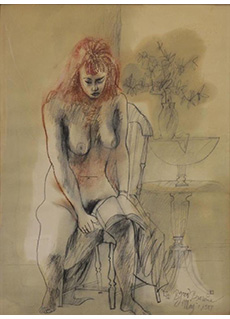
Abstract Expressionism
 American
American
Byron Browne (American, 1907–1961) was a founder of Abstract Expressionism and a key figure in the American Avant-Garde scene of the 1930s and 1940s. Browne was born in New York and spent most of his life between the city and Lakewood, New Jersey. Browne studied at the National Academy of Design and became lifelong friends with another Abstract Expressionist, Arshile Gorky. Browne was such a proponent of Abstract Art that he destroyed his early students work that featured a more traditional style. The influence of Cubism and Surrealism is apparent in most of his work, taking cues from Pablo Picasso, Georges Braque, and Joan Miró.
Byron Browne (American, 1907–1961) was a founder of Abstract Expressionism and a key figure in the American Avant-Garde scene of the 1930s and 1940s. Browne was born in New York and spent most of his life between the city and Lakewood, New Jersey. Browne studied at the National Academy of Design and became lifelong friends with another Abstract Expressionist, Arshile Gorky. Browne was such a proponent of Abstract Art that he destroyed his early students work that featured a more traditional style. The influence of Cubism and Surrealism is apparent in most of his work, taking cues from Pablo Picasso, Georges Braque, and Joan Miró.
In 1940 Browne became a founding member of the Federation of Modern Painters and Sculptors, Inc., with Ilya Bolotwosky, Adolph Gottlieb, Balcomb Greene, and Mark Rothko. The artists, all members of the American Artists’ Congress, formed the Federation with a newfound commitment to aesthetic concerns as the Artists’ Congress found itself embedded in political controversy. The establishment of the Federation marked a new commitment to working towards the diversification and exhibition of nonacademic American art.
Browne began holding solo exhibitions of his avant-garde work in 1933. Only two years later the first exhibition of his work with the Whitney Museum of American Art occurred at the 1935 “Abstract Painting in America” show, which featured Balcomb Greene, Arshile Gorky, and Stuart Davis. During the 1930s Browne found employment in the New Deal’s Federal Works of Art Project. After brief enrollment in the Easel division he entered the Mural division, designing murals for the United States Passport Office in Rockefeller Center, the radio station WNYC, and the Science and Health Building at the 1939 World’s Fair in New York. Together with Stuart Davis, Arshile Gorky, Karl Knaths, Willem de Kooning, Louis Schanker, and John Von Wicht, his works became definitive in the conception of abstract mural painting in America.
Towards the end of his life Browne became active in the artists’ colony of Provincetown, Massachusetts. He spent over a decade teaching at the Art Students League, and also held a position as a professor of advanced painting at New York University. On December 25, 1961, Browne died in New York at 54. Through his distinct interest in the act of representation within the modernist discourse, Browne re-conceptualized figural art for the twentieth century. His approach to the human figure and the advancements of his stylistic techniques left a striking impression on the abstract art movement in America.